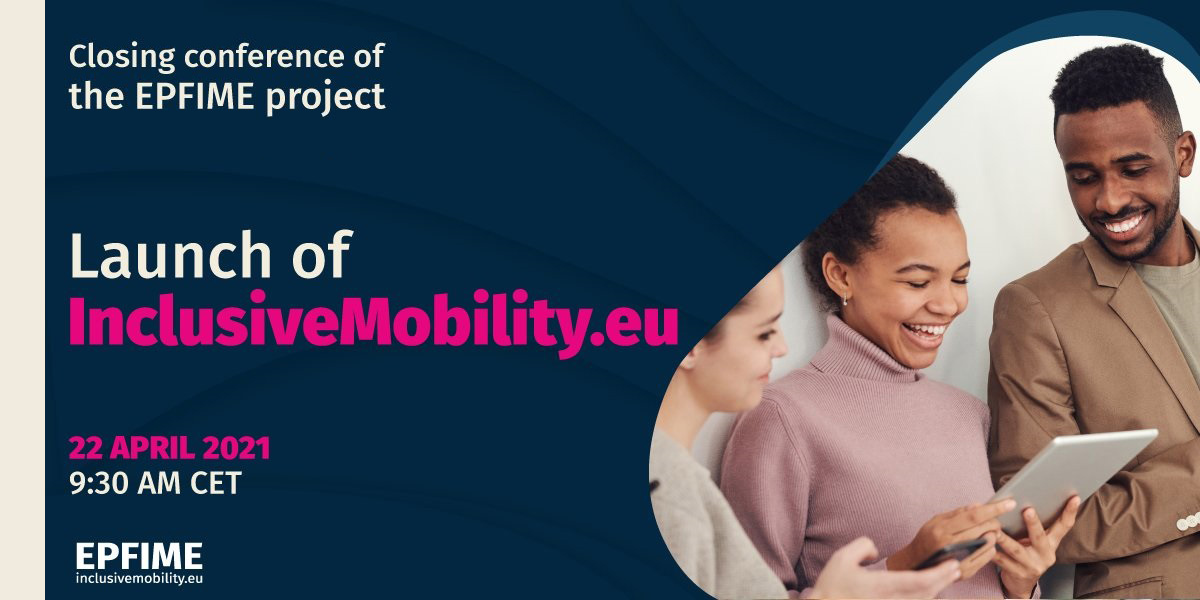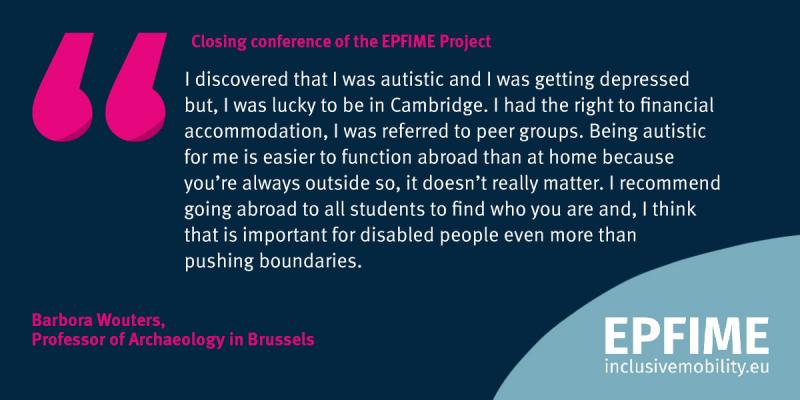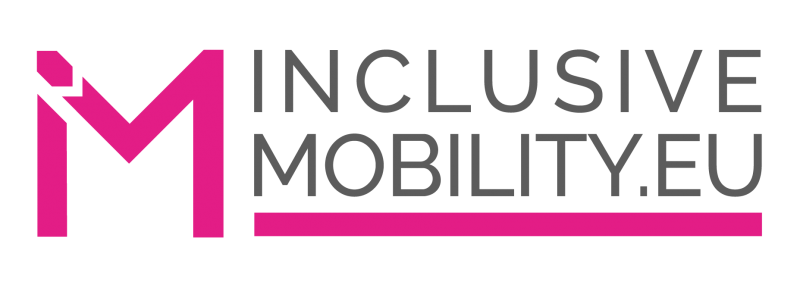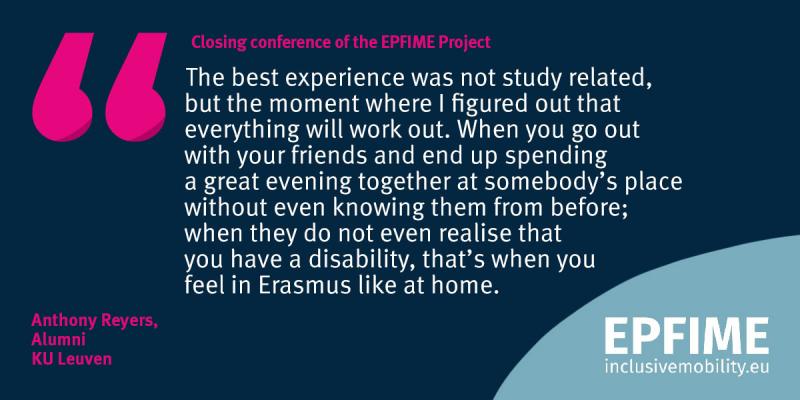
The Erasmus+ Programme aims at making the international mobility experience accessible to all, sharing with all citizens the benefits of the programme in terms of upskilling, academic curricula, job opportunities, and networking. Particular attention is given to people from disadvantaged backgrounds for whom access to the mobility experience is not evident. This category of students is complex and variegated and the needs are unique to the specific situation of each student. One such group of students is the students with disabilities that face various hurdles when wanting to access a mobility experience abroad.
There are different types of disabilities, all bringing in common the need for quality information. The Erasmus Student Network, partnering with the Flemish Ministry of Education and Training, the Support Centre for Inclusive Higher Education (SIHO), the Irish Universities Association (IUA), and the Association for Higher Education Access & Disability (AHEAD) answered this major need on the European landscape via the EU-funded project EPFIME.
The conference has been recorded and is available on the SIHO website.
The InclusivemMobility.eu platform, at last!
EPFIME worked intensively these past two years to develop the InclusiveMobility.eu platform that was presented and launched during the project’s final conference of 22 April. The project built on the Bologna priorities, creating tools to support universities, national authorities, and national Erasmus+ agencies to foster inclusive mobility.
What is “Inclusive Mobility”? It means creating and ensuring adequate conditions to learn, work, or volunteer abroad for people with fewer opportunities, by addressing diverse support needs. A needs-based approach is adopted to ensure safe and exciting mobility periods abroad while remembering that needs are not to be generalised, but rather understood as individual and specific.
The main output of this project is the InclusiveMobility.eu platform, centralising information on inclusive mobility from higher education institutions (HEIs), national agencies, and authorities. The platform contains information about HEIs, testimonials, and the inclusion and support measures adopted by the different Higher Education Area countries. Higher education students can find information on how to go abroad while institutions, national agencies, and authorities are invited to register and add their information to be featured on the platform.

The platform and co-creation: by the users for the users
The presentation of the InclusiveMobility.eu platform by the Erasmus Student Network during the project conference showcased more in detail the various components of the platform and how they work together, showing the intuitiveness of the tool and the added value that the various resources and sections offer to foster mobility for students with disabilities, HEIs, national agencies, and authorities.
The components include an interactive map, step-by-step guides on how to go abroad, testimonials from peers and experts, and easy-to-access information on support measures that the registered education institutions can share within the platform.
The contribution of education institutions will be key to ensure that the platform has relevant information to be shared with end-users. Currently the platform is institution-based and not faculty-based to foster a comprehensive and institutional approach toward the platform.
One of the conference’s participants asked if the disability definition within EPFIME includes mental health issues. Valérie Van Hees, from SIHO, explained that the natural development of EPFIME, that is the PLAR-4-SIMP project, is precisely working to include all people with fewer opportunities including people affected by mental health issues synergising strongly with the InclusiveMobility.eu platform developed. Institutions can register as such via an institutional email that is subsequently approved.
This final conference is not the end of the project. It’s an ongoing process, the platform will be populated by institutions, can develop new types and information, and we look forward to the integration with other tools.
Magalie Soenen, Project coordinator & Policy Advisor Higher Education
We at the Erasmus Student Network invite all institutions to upload information and keep it updated to ensure that students have access to information that is accurate and qualitative.
Workshop time! An institution’s journey to inclusivity and empowerment via the platform
During the conference, the participants were involved in an ad hoc workshop designed to showcase the outputs available on the platform, including the guidelines, the inclusive mobility framework, the inclusive mobility toolbox, the self-assessment tool, and more.
1, The workshop imagined the journey of a higher education institution wanting to strengthen its inclusion capacity. By accessing the platform and starting with the self-assessment tool the institution can understand its current strengths and weaknesses and receive tips and guidelines in the form of action points.
2. The institution in our journey, be it an HEI, national agency, or ministry of education, then proceeds to the inclusive mobility framework selecting the inclusion objectives and receiving further action points based on the selected goals to improve their inclusion both for incoming and outgoing students.
3. The institution is now ready to find out more about inclusive mobility and proceeds toward the mobility toolbox which offers a wide range of resources to foster inclusive mobility based on the type of institutions, needs, country, sector, target area, and more.
4. Thanks to these tools, the institution manages to improve its inclusivity in mobility and is empowered to develop its own resources. Hence, the institution is ready to give back; using the upload resource page of the toolbox section of the platform, the institution shares its content and resources contributing to the sustainability of the platform, to the sharing of good practices, and to foster inclusive mobility.
The material submitted by the institution is assessed by SIHO to ensure quality and after acceptance the toolbox resource library is fully enriched allowing for the virtuous cycle to start again benefitting other institutions like the one of our journey.
During the conference the participants are involved in ad-hoc #workshop activities designed to showcase the outputs available on the https://t.co/2L9XDUXCO0 platform, including guidelines, inclusive mobility framework, inclusive mobility #toolbox, self-assessment tool & more.⚙️ pic.twitter.com/VChvYltlq1
— ESN International (@ESN_Int) April 22, 2021
More InclusiveMobility.eu goodies
The next piece of the InclusiveMobiliy.eu infrastructure comes from the Guidelines targeting HEIs. The Guidelines are specific for students with disabilities but the areas addressed are also adaptable to other contexts. The Guidelines focus on key areas, namely inclusion in mobility strategies, collaboration, information provision, and mobility promotion, grants, and support service offering advice, tips, tricks, and examples of good practices for institutions at whatever stage of the inclusive mobility journey.
Going into mobility feeds into your career development. Moreover, we should not forget about what happens post-mobility. It is important to use the mobility experience to influence other students to go abroad. Student ambassadors are key.
Lorraine Gallagher, Information & Training Officer at AHEAD
What are you waiting for?
Finally, don’t forget to be part of this process by prompting your institution to register at the platform if you’re a student. Start by tagging your higher education institution, linking them to the InclusiveMobility.eu platform.
If you’re an institution, your cooperation will be key to make a dramatic positive change for students like Anthony and future professionals like Barbora. Start your inclusivity process and register your institution on the platform!
The blended mobility approach will be a setting stone for longer mobilities, for those that come from disadvantaged backgrounds.
For the Erasmus+ App we need to start talking about how to make it extensible for everybody and how we can integrate all the information available through the InclusiveMobility.eu platform.
We have direct contact with the national authorities, with NAs, education institutions and we are able to work together to create awareness to make this happen.
From today onwards, institutions can register and fill in the information. We rely also on you to help us spread the word.
Nadia Manzoni, Policy officer, DG EAC European Commission



Follow ESN